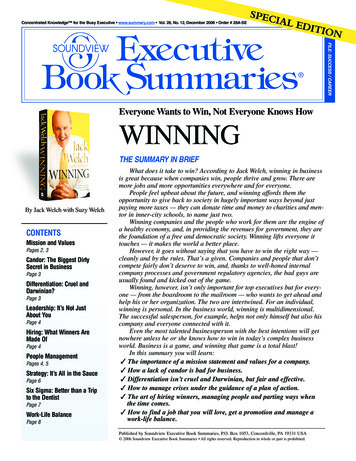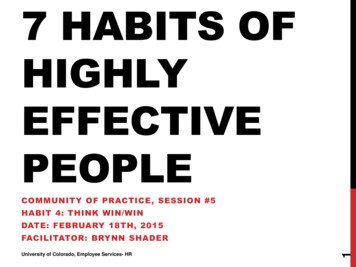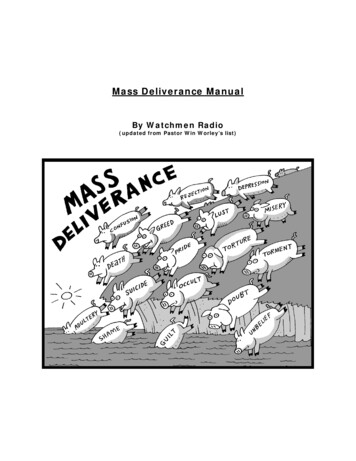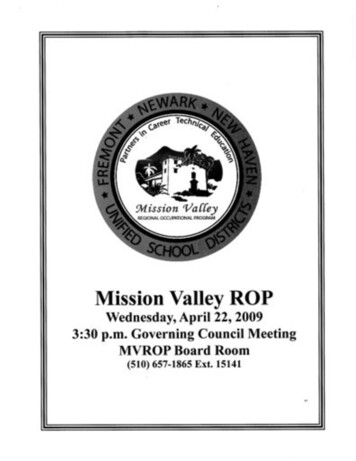
Transcription
Concentrated Knowledge for the Busy Executive www.summary.com Vol. 28, No. 12, December 2006 Order # 28A-SESPECIAL EDITIONEveryone Wants to Win, Not Everyone Knows HowWINNINGTHE SUMMARY IN BRIEFBy Jack Welch with Suzy WelchCONTENTSMission and ValuesPages 2, 3Candor: The Biggest DirtySecret in BusinessPage 3Differentiation: Cruel andDarwinian?Page 3Leadership: It’s Not JustAbout YouPage 4Hiring: What Winners AreMade OfPage 4People ManagementPages 4, 5Strategy: It’s All in the SaucePage 6Six Sigma: Better than a Tripto the DentistPage 7Work-Life BalancePage 8What does it take to win? According to Jack Welch, winning in businessis great because when companies win, people thrive and grow. There aremore jobs and more opportunities everywhere and for everyone.People feel upbeat about the future, and winning affords them theopportunity to give back to society in hugely important ways beyond justpaying more taxes — they can donate time and money to charities and mentor in inner-city schools, to name just two.Winning companies and the people who work for them are the engine ofa healthy economy, and, in providing the revenues for government, they arethe foundation of a free and democratic society. Winning lifts everyone ittouches — it makes the world a better place.However, it goes without saying that you have to win the right way ––cleanly and by the rules. That’s a given. Companies and people that don’tcompete fairly don’t deserve to win, and, thanks to well-honed internalcompany processes and government regulatory agencies, the bad guys areusually found and kicked out of the game.Winning, however, isn’t only important for top executives but for everyone — from the boardroom to the mailroom — who wants to get ahead andhelp his or her organization. The two are intertwined. For an individual,winning is personal. In the business world, winning is multidimensional.The successful salesperson, for example, helps not only himself but also hiscompany and everyone connected with it.Even the most talented businessperson with the best intentions will getnowhere unless he or she knows how to win in today’s complex businessworld. Business is a game, and winning that game is a total blast!In this summary you will learn: The importance of a mission statement and values for a company. How a lack of candor is bad for business. Differentiation isn’t cruel and Darwinian, but fair and effective. How to manage crises under the guidance of a plan of action. The art of hiring winners, managing people and parting ways whenthe time comes. How to find a job that you will love, get a promotion and manage awork-life balance.Published by Soundview Executive Book Summaries, P.O. Box 1053, Concordville, PA 19331 USA 2006 Soundview Executive Book Summaries All rights reserved. Reproduction in whole or part is prohibited.FILE: SUCCESS / CAREER
WINNINGBy Jack Welch with Suzy Welch— THE COMPLETE SPECIAL EDITION SUMMARYPART 1-UNDERNEATH IT ALLMission and ValuesMission and values are two terms that are among themost abstract, overused and misunderstood words inbusiness. By contrast, a good mission statement and agood set of values are real and concrete. The missionannounces exactly where you are going, and the valuesdescribe the behaviors that will get you there.First: About That MissionAn effective mission statement basically answers onequestion: How do we intend to win in this business? Itrequires companies to make choices about people,investments and other resources and prevents companiesfrom falling into the common mission trap of assertingthey will be all things to all people at all times.Effective mission statements balance the possible andthe impossible. They give people a clear sense of thedirection to profitability and the inspiration to feel theyare part of something big and important. You can getinput from anywhere. However, a mission cannot, andmust not, be delegated to anyone except the people ultimately held accountable for it.Bank One’s Values Never let profit-center conflicts get in the wayof doing what is right for the customer. Give customers a good, fair deal. Great customer relationships take time. Do not try to maximize short-term profits at the expense of buildingthose enduring relationships. Always look for ways to make it easier to dobusiness with us. Communicate daily with your customers. Ifthey are talking to you, they can’t be talking to acompetitor. Don’t forget to say thank you.together as a winning proposition, they have to be mutually reinforcing. Examples of disconnections mayappear minor or temporary, but, when left unattended,they can really hurt a company. In the worst-case scenario, they can literally destroy a business.In its prior life, Enron was a simple, rather mundanepipeline and energy company. Then the company(continued on page 3). And Now About Those ValuesIn contrast to the creation of a mission, everyone in acompany should have something to say about values.You can use company-wide meetings, training sessionsand the like for immediate feedback and the intranet forbroader input. The executive team has to go out of theirway to be sure they’ve created an atmosphere wherepeople feel it is their obligation to contribute.It’s in the Nitty Gritty DetailsAct in a boundaryless fashion: Always search for andapply the best ideas regardless of their source; be tolerant of the bureaucracy; and see change for the growthopportunity that it brings.Take the value “We treat customers the way we wouldwant to be treated.” That’s pretty tangible, but Bank Onehad identified a number of behaviors that made thatvalue come to life.For a company’s mission and values to truly workThe authors: Jack Welch joined GE in 1960, and by 1981he became the company’s eighth chairman and CEO. Welchleft GE in 2001, and is currently the head of Jack WelchLLC, where he is an advisor to Fortune 500 CEOs and holdspublic speaking engagements. He is also the author of Jack:Straight from the Gut, a New York Times’ best seller.Suzy Welch, Jack’s wife, is the former editor of theHarvard Business Review, as well as an author of a number of articles on creativity, change, leadership and organizational behavior.Winning by Jack Welch with Suzy Welch. Copyright 2005 by Jack Welch, LLC. Summarized by permission ofthe publisher, HarperBusiness. 372 pages. 27.95. ISBN 006-075394-3.Summary Copyright 2006 by Soundview ExecutiveBook Summaries, www.summary.com, 1-800-SUMMARY,610-558-9495.For additional information on the authors,go to: http://my.summary.comPublished by Soundview Executive Book Summaries (ISSN 0747-2196), P.O. Box 1053, Concordville, PA19331 USA, a division of Concentrated Knowledge Corp. Published monthly. Subscriptions: 209 per year in theUnited States, Canada and Mexico, and 295 to all other countries. Periodicals postage paid at Concordville, Pa.,and additional offices.Postmaster: Send address changes to Soundview, P.O. Box 1053, Concordville, PA 19331. Copyright 2006by Soundview Executive Book Summaries.Available formats: Summaries are available in print, audio and electronic formats. To subscribe, call us at1-800-SUMMARY (610-558-9495 outside the United States and Canada), or order on the Internet at www.summary.com.Multiple-subscription discounts and corporate site licenses are also available.2Soundview Executive Book Summaries SoundviewExecutive Book Summaries CHRIS BACHLER – Contributing EditorDEBRA A. DEPRINZIO – Senior Graphic DesignerMELISSA WARD – EditorLINDA GROSS – Editor in ChiefREBECCA S. CLEMENT – Publisher
Winning — SPECIAL EDITION SUMMARYMission and Values(continued from page 2)changed missions. Someone got the idea to turn Enroninto a trading company. The goal was faster growth. Itwas in that context — of no context — that Enron’s collapse occurred.Your company will not reach anywhere near its fullpotential if all that is guiding it is a list of pleasant platitudes hanging on the lobby wall. Candor: The Biggest DirtyLittle Secret in BusinessLack of candor blocks smart ideas, fast action andgood people contributing all the stuff they’ve got. It’s akiller. When you’ve got candor, everything just operatesfaster and better.The Candor EffectFirst, candor gets more people in the conversation.Second, candor generates speed. Third, candor cutscosts. Given the advantages of candor, you have to wonder why we don’t have more of it in business.The make-or-break importance of candor in U.S. business is relatively new. Up until the early 1980s, big companies like GE and thousands of others operated largelywithout it. They had virtually no global competition.Even though candor is vital to winning, it is hard andtime-consuming to instill in any group, no matter whatsize. But it can be done. To get candor, you reward it,praise it and talk about it. You make public heroes outof people who demonstrate it. Most of all, you yourselfdemonstrate it in an exuberant and even exaggeratedway — even when you’re not the boss. Differentiation: Cruel andDarwinian?Companies win when their managers make a clearand meaningful distinction between top- and bottomperforming businesses and people. Companies sufferwhen every business and person is treated equally.Differentiation is the most efficient and most effectiveway to run your company, and also happens to be thefairest and the kindest. Ultimately, it makes winners outof everyone. However, differentiation cannot — andmust not — be implemented quickly. At GE, it tookabout a decade to install the kind of candor and trustthat makes differentiation possible.Every company has strong businesses or product linesand weak ones and some in between. Differentiationrequires managers to know which is which and to investaccordingly. At GE, “strong” meant a business was No.1 or No. 2 in its market. If it wasn’t, the managers hadto fix it, sell it or, as a last resort, close it.Differentiation among your businesses or productlines requires a transparent framework that everyone inthe company understands.Differentiation and PeopleThis process requires managers to assess theiremployees and separate them into three categories interms of performance: top 20 percent, middle 70, andbottom 10. Then — and this is key — it requires managers to act on that distinction.When people differentiation is real, the top 20 percentof employees are showered with bonuses, stock options,praise and a variety of rewards to their pocketbooks andsouls.The middle 70 percent are managed differently. Thisgroup is enormously valuable to any company; you simply cannot function without their skills, energy and commitment. After all, they are the majority of your employees. And that’s the major challenge and risk in 20-70-10— keeping the middle 70 engaged and motivated.Managing the middle 70 is not about keeping peopleout of the bottom 10. It is not about saving poor performers. Rather, differentiation is about managers looking at the middle 70, identifying people with potentialto move up and cultivating them.As for the bottom 10 percent in differentiation, theyhave to go. If you have a candid organization with clearperformance expectations and a performance evaluationprocess, then people in the bottom 10 percent generallyknow who they are. When you tell them, they usuallyleave before you ask them to. Voice and DignityEvery person in the world wants voice and dignity,and every person deserves them. When you run a unit ordivision, you rarely think that people aren’t speaking upor that they’re not respected. It feels like the peoplearound you certainly are, and your days are filled withvisits, calls and notes from people with strong opinions.But the majority of people in most organizations don’tsay anything because they feel they can’t — andbecause they haven’t been asked.In an effort to create an environment where peoplecould feel comfortable expressing opinions and askingquestions, the Work-Out process was born and held atGE sites around the world. Patterned after New Englandtown meetings, groups of 30 to 100 employees wouldcome together with an outside facilitator to discuss better ways of doing things and how to eliminate some ofthe bureaucracy and roadblocks that were hinderingSoundview Executive Book Summaries (continued on page 4)3
Winning — SPECIAL EDITION SUMMARYVoice and Dignity(continued from page 3)them. The boss would be present at the beginning ofeach session, laying out the rationale for the Work-Out.He or she would also commit to two things: to give anon-the-spot yes or no to 75 percent of the recommendations that came out of the session and to resolve theremaining 25 percent within 30 days.The boss would then disappear until the end of thesession, so as not to stifle open discussion and returnonly at the end of the Work-Out to make good on his orher promise.Tens of thousands of these sessions took place overseveral years, until they became a way of life in thecompany. They are no longer big events but part of howGE goes about solving problems. PART TWO: YOUR COMPANYLeadership: It’s Not JustAbout YouWhen you become a leader, success is all about growingothers. Without question, there are a variety of ways to be aleader.What Leaders Do1. Leaders relentlessly upgrade their team, usingevery encounter as an opportunity to evaluate, coachand build self-confidence. You need to invest the vastmajority of your time and energy as a leader in threeactivities: evaluating, coaching and building the team’sself-confidence. Too often, managers think that peopledevelopment occurs once a year in performance reviews.2. Leaders make sure people not only see the vision,they live and breathe it. As a leader, you have to makethe vision come alive. Goals cannot sound noble yet bevague. One of the most common problems in organizations is that leaders communicate the vision to their closest colleagues and its implications never filter down topeople in frontline positions.3. Leaders get into everyone’s skin, exuding positiveenergy and optimism. An upbeat manager ends up running a team or organization filled with upbeat people. Apessimistic sourpuss somehow ends up with an unhappytribe all his own4. Leaders establish trust with candor, transparencyand credit. Trust happens when leaders are transparent,candid and keep their word.5. Leaders have the courage to make unpopular decisions and gut calls. Some people long to be loved byeveryone. Those behaviors can get you in the soup if youare a leader because there are times you have to make harddecisions — let people go, cut funding to a project or closea plant. A lot has been written about the mystery of gut,but it’s really just pattern recognition. Leaders are facedwith gut calls all the time, and sometimes the hardest gutcalls involve hiring people. However, if you’re left withthat uh-oh feeling in your stomach, don’t hire the guy.6. Leaders probe and push with a curiosity that borders on skepticism, making sure their questions areanswered with action. When you’re a leader, your job isto have all the questions. You have to be incredibly comfortable looking like the dumbest person in the room.7. Leaders inspire risk-taking and learning by setting the example. Winning companies embrace risk-taking and learning. But in reality, these two concepts oftenget little else than lip service. If you want your people toexperiment and expand their minds, set the example yourself. Consider risk-taking.8. Leaders celebrate. There is not enough celebratingat work — anywhere. Celebrating makes people feel likewinners and creates an atmosphere of recognition andpositive energy. Hiring: What Winners AreMade OfHiring good people is hard. Hiring great people isbrutally hard. Nothing matters more in winning thangetting the right people on the field. However, beforeyou think about assessing people for a job, they have topass through three screens. The first test is for integrity.People with integrity tell the truth, and they keep theirword. They take responsibility for past actions, admitmistakes and fix them.The second test is for intelligence. The candidate hasa strong dose of intellectual curiosity, with a breadth ofknowledge to work with or lead other smart people intoday’s complex world.The third ticket to the game is maturity. Mature individuals can withstand heat, handle stress and setbacksand alternatively — when those moments arise — enjoysuccess with equal parts of joy and humility. People ManagementOnce you have the right players for the field, theyneed to be managed. People management comes downto six fundamental practices:1. Elevate HR to a position of power and primacyin the organization and make sure HR people have(continued on page 5)4Soundview Executive Book Summaries
Winning — SPECIAL EDITION SUMMARYChange: Mountains Do MovePeople Management(continued from page 4)the special qualities to help managers build leadersand career.2. Use a rigorous, nonbureaucratic evaluation system and intensely monitor its integrity.3. Create effective mechanisms — such as money,recognition and training — to motivate and retain.4. Face straight into charged relationships withunions, stars, sliders and disrupters. You can fightabout issues, but your fighting will be more productiveif you are always clear about what issues are negotiableand which are untouchable.5. Fight gravity. Instead of taking the middle 70percent for granted, treat them like the heart andsoul of the organization.6. Design the organizational chart to be as flat aspossible, with clear reporting relationships andresponsibilities. If you want to manage people effectively, help your people by making sure the organizational chart leaves as little as possible to the imagination. The trick is to have fewer rungs. Make your company 50 percent flatter than you’d normally feel comfortable with; managers should have 10 direct reports atthe minimum, and 30 to 50 percent more if they’reexperienced. Parting WaysSometimes people have to be let go due to integrityviolations, layoffs due to economic downturns and firings for nonperformance. For integrity violations, youdon’t need to hesitate. Just do it and make sure the organization knows why, so the consequences of breakingthe rules are not lost on anyone.Layoffs due to the economy are more complicated.Every employee should know how the company isdoing. That way, if layoffs occur, at least people willhave some level of preparation.The most complex and delicate firing is when an individual has to be let go because of poor performance.Usually, firings for nonperformance aren’t black andwhite. Because of that, there are three main ways thatmanagers get firing wrong — moving too fast, not usingenough candor and taking too long.How can you get it right? First, no surprises. A goodperformance evaluation process informs and preparespeople in a fair and open way. Second, minimize humiliation; build up a person’s self-confidence. Let the individual know there is a good job for him or her out there.Your goal for the fired employee is a soft landing wherever he or she goes. Change is a critical part of business. You need tochange, preferably before you have to. Most people hateit; they love familiarity and patterns and cling to them.But attributing a behavior to human nature doesn’t meanyou have to be controlled by it. Instead, it comes downto embracing four practices:1. Attach every change initiative to a clear purposeor goal. Change for change’s sake is stupid andenervating.2. Hire and promote only true believers and geton-with-it types.3. Remove the resisters, even if their performanceis satisfactory.4. Look at car wrecks.Most companies capitalize on obvious opportunities.But to be a real change organization, you also need theguts to look at bolder, scarier, more unpredictable eventsand to make the most of the opportunities.Bankruptcies, for example, are a calamity that provideall kinds of opportunities.Most companies take advantage of obvious opportunities. But some also have the ability to make the most ofregrettable circumstances — those “car wrecks” — andthey should. These companies will benefit from realizing that change means seizing opportunity, even theones wrought by adversity. Crisis ManagementAs long as companies are made up of human beings,there will be mistakes, controversies and blowups. Thecold truth is that some degree of unwanted and unacceptable behavior is inevitable. Crises demand fromleaders a daunting balancing act. On one hand, you’vegot to throw everything you’ve got into understandingand solving the crisis. At the same time, you have to putthat activity into a compartment and carry on as if nothing is actually wrong. That’s what leaders usuallyneglect — to their regret.You can be proactive in preventing some crises inthree main ways. First, tight controls, such as disciplined financial and accounting systems with toughinternal and external auditing processes, should be used;an organization’s line managers should be required toreview and act on every audit’s findings.Second, try to prevent crises with good internalprocesses, such as rigorous hiring procedures, candid performance reviews and comprehensive training programs,that make the company’s policies crystal clear. Third,have a culture of integrity, meaning a culture of honesty,transparency, fairness and strict adherence to rules.(continued on page 6)Soundview Executive Book Summaries 5
Winning — SPECIAL EDITION SUMMARYAssume you and your organization’s handling ofthe crisis will be portrayed in the worst possiblelight. Reporters are not in the business of telling yourside of the story. Along with disclosing the full extent ofyour problem, you’ve got to stand up and define yourposition before someone else does. Assume there will be changes in processes andpeople. Crises require change. Sometimes a process fixis enough. That’s because the people affected by the crisis — or sometimes those watching it — demand thatsomeone be held responsible. Assume the organization will survive, ultimatelystronger for what happened. After a crisis is over,there is always the tendency to want to put it away in adrawer. Don’t — teach its lessons every chance you get.In doing so, you’ll spread the immunity. Crisis Management(continued from page 5)Most of the time, crises blindside you because they don’tdetonate like bombs — they emerge in fits and starts.Plan of ActionThe following assumptions aren’t a formula for managing a crisis, but hopefully they’ll provide directionalguidance while dealing with a crisis: Assume the problem is worse than it appears.Few crises start small and stay that way, so adjust yourmind-set early on. Assume there are no secrets in the world, andeveryone will eventually find out everything. Themore openly you speak about the problem, the moretrust you earn from everyone watching.PART THREE: YOUR COMPETITIONStrategy: It’s All in the SauceIn real life, strategy is actually very straightforward.You pick a general direction and implement like hell.The steps are: First, come up with a big idea for your business —Welch’s Questions to MakingStrategy Real1. What does the playing field looks like now? Who are the competitors? Who has what share in each market?2. What has the competition been up to? What has each competitor done in the pastyear to change the playing field? Are there any new entrants, and what have theybeen up to in the past year?3. What have you been up to? Have you bought another company, introduceda new product, stolen a competitor’s key salesperson or licensed a new technology from astart-up? Have you lost any competitive advantages thatyou once had — a great salesperson, specialproduct, a proprietary technology?4. What’s around the corner? What scares you the most in the year ahead? What new products or technologies could yourcompetitors launch that might change thegame?5. What’s your winning move? What can you do to change the playing field? What can you do to make customers stick toyou more than ever before and more than toanyone else?6a smart, realistic, relatively fast way to gain sustainablecompetitive advantage. Second, put the right people in the right jobs todrive the big idea forward. Third, relentlessly seek out the best practices toachieve your big idea, whether inside or out, adapt themand continually improve them.Strategy means making clear-cut choices about how tocompete. You cannot be everything to everybody.Corner stores have learned that survival depends onfinding a strategic position where no one can beat them.Big companies have the same challenge. BudgetingThe budgeting process at most companies has to bethe most ineffective practice in management. It sucksthe energy, time, fun and big dreams out of an organization. It also brings out the most unproductive behaviorsin an organization, from sandbagging to settling formediocrity.In all their assumptions, the people in the field areoperating with one simple goal, albeit unstated: to minimize their risk and maximize their bonus.Senior managers are also preparing for the big budgetmeeting. Their agenda is the opposite of the field.They’re rewarded for increased earnings, and so whatthey want from the budget review at every business issignificant growth in sales and profits.A Better WayThe problem is that companies often deliver only afraction of what they could, and they take all the fun outof setting financial goals.Soundview Executive Book Summaries (continued on page 7)
Winning — SPECIAL EDITION SUMMARYBudgetingBelieving that a merger of equals can actuallyoccur. Focusing so intently on strategic fit that you fail toassess cultural fit, which is just as important to a merger’s success. Entering into a “reverse hostage situation,” inwhich the acquirer ends up making so many concessions during negotiations that the acquired ends up calling all the shots afterward. Integrating too timidly. With good leadership, amerger should be complete within 90 days. The conqueror syndrome, in which the acquiringcompany marches in and installs its own managerseverywhere, undermining one of the reasons for anymerger. Paying too much — so much that the premium cannever be recouped in the integration. Resistance. In a merger, new owners will alwaysselect people with buy-in over resisters with brains. Ifyou want to survive, get over your angst and learn tolove the deal as much as they do. (continued from page 6)Imagine a budgeting system where both the field andheadquarters have a shared goal: to use the budgetingprocess to ferret out every possible opportunity forgrowth, identify real obstacles in the environment andcome up with a plan for stretching dreams to the sky.That system is linked to the strategic planning process inthat it is focused on two questions: How can we beat last year’s performance? What is our competition doing and how can we beatthem?If you focus on these two questions, the budgetingprocess becomes a wide-ranging, anything-goes dialoguebetween the field and headquarters about opportunitiesand obstacles in the real world.Through these discussions, both sides of the table jointly come up with a growth scenario that is not negotiatedor imposed and cannot really be called a budget at all. It isan operating plan for the next year, filled with aspiration,primarily directional and containing numbers that aremutually understood to be targets, or numbers that couldbe called “best efforts.” Organic GrowthStarting something new from within an establishedcompany requires managers to act against many of theirreasonable instincts. But to give any new venture afighting chance to succeed, you have to set it free andspend more money on it.Managing a 50,000 new product line in its first yearis harder than managing a 500 million business in its20th year. That’s why they need special treatment. Toooften they don’t get it.There are three common mistakes companies make inlaunching something. First, they don’t flood start-up ventures with adequate resources, especially on the peoplefront. Second, they make too little fanfare about thepromise and importance of the new venture. Instead ofcheering about its potential, they tend to hide it under abushel. Third, they limit the new venture’s autonomy. Mergers and Acquisitions: DealHeat and Other Deadly SinsMergers and acquisitions give you a faster route toprofitable growth. They quickly add geographical andtechnological scope and bring on board new products andcustomers.Merging right is ultimately about avoiding seven pitfalls, meaning mistakes or errors in judgment. These are:Six Sigma: Better than a Tripto the DentistNothing compares to the effectiveness of Six Sigmawhen it comes to improving a company’s operational efficiency, raising its productivity and lowering its costs. Itimproves design processes, gets products to the marketfaster with fewer defects and builds customer loyalty.Perhaps the biggest benefit of Six Sigma is its capacity todevelop a cadre of leaders.Simple, Complex or Not at AllSix Sigma has two primary applications. First, it can beused to remove the variation in routine, relatively simple,repetitive tasks. And second, it can be used to make surelarge, complex projects go right the first time.For the first application, the level of training and education is certainly manageable. In order to discover theroot causes of inconsistencies, people need to knowwhat kind of information to gather and how to analyzeit. The rigor of this type of training has a terrific sideeffect. It builds critical thinking and discipline. The second application involves a sophisticated level of trainingand statistical analysis.Six Sigma is meant for and has its most meaningfulimpact on repetitive internal processes and complexproduct designs. Once you understand the simplemaxim “variation is evil,” you’re 60 percent of the wayto becoming an expert. The other 40 percent is gettingthe evil out. Soundview Executive Book Summaries 7
Winning — SPECIAL EDITION SUMMARYPART FOUR
WINNING THE SUMMARY IN BRIEF What does it take to win? According to Jack Welch, winning in business is great because when companies win, people thrive and grow. There are more jobs and more opportunities everywhere and for everyone. People feel upbeat about the futureand winning a, ffords them the










